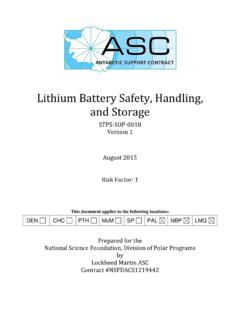Transcription of EXPOSURE TO LEAD: A MAJOR PUBLIC HEALTH CONCERN
1 PREVENTING DISEASE THROUGH HEALTHY ENVIRONMENTS EXPOSURE TO LEAD: A MAJOR PUBLIC HEALTH CONCERN Lead is a toxic metal whose widespread use has caused extensive environmental contamination and HEALTH problems in many parts of the world . It is a cumulative toxicant that affects multiple body systems, including the neurological, haematological, gastrointestinal, cardiovascular and renal systems. Children are particularly vulnerable to the neurotoxic effects of lead, and even relatively low levels of EXPOSURE can cause serious and, in some cases, irreversible neurological ,2 Lead EXPOSURE is estimated to account for of the global burden of disease, with the highest burden in developing Recent reductions in the use of lead in petrol (gasoline), paint, plumbing and solder have resulted in substantial reductions in lead levels in the However, significant sources of EXPOSURE to lead still remain, particularly in developing countries.
2 Further efforts are required to continue to reduce the use and releases of lead and to reduce environmental and occupational exposures, particularly for children and women of child-bearing age. Sources of EXPOSURE to lead Lead is found at low levels in Earth s crust, mainly as lead However, the widespread occurrence of lead in the environment is largely the result of human activity, such as mining, smelting, refining and informal recycling of lead; use of leaded petrol (gasoline); production of lead-acid batteries and paints; jewellery making, soldering, ceramics and leaded glass manufacture in informal and cottage (home-based) industries; electronic waste5; and use in water pipes and solder. Other sources of lead in the environment include natural activities, such as volcanic activity, geochemical weathering and sea spray emissions, and remobilization of historic sources, such as lead in soil, sediment and water from mining areas.
3 As lead is an element, once it is released into the environment, it Because of lead s persistence and potential for global atmospheric transport, atmospheric emissions affect even the most remote regions of the Industrial processes1,2 Lead is used mainly in the production of lead-acid batteries, plumbing materials and alloys. Other uses are in cable sheathing, paints, glazes and ammunition. Human occupational EXPOSURE can also take place during the application and removal of protective lead-containing paints, during the grinding, welding and cutting of materials painted with lead-containing paints, such as in shipbuilding, construction, demolition industries, and fabrication of heavy lead glass and crystal, and in crystal carving. Mining, smelting, and informal processing and recycling of electric and electronic waste can also be significant sources of EXPOSURE .
4 Lead has been used widely in the form of tetraethyl and tetramethyl lead as antiknock and lubricating agents in petrol, although the majority of lead is emitted from vehicles in the form of inorganic particles. This use has been phased out in most countries, which has resulted in a significant reduction of human EXPOSURE and mean blood lead levels. In the few parts of the world where leaded petrol is still in use, however, it continues to be a MAJOR source of EXPOSURE . Old industrial hotspots that have not been cleaned up can also represent a hazard even years after contamination has stopped, particularly to children who might ingest contaminated soil or dust as a result of their hand-to-mouth behaviour. Food and smoking For the non-smoking general population, the largest contribution to the daily intake of lead is derived from the ingestion of food, dirt and dust.
5 The amount of lead in food plants depends on soil concentrations and is highest around mines and smelters. Cereals can contain high levels of lead, and spices may be contaminated with lead. The use of lead-soldered food and beverage cans (which is now diminishing) may considerably increase the lead content of the food or beverage, especially in the case of acidic foods or drinks. As alcoholic drinks tend to be acidic, the use of any lead-containing products in their manufacture, distribution or storage will raise lead levels. Migration of lead into food from lead-glazed ceramic or pottery dinnerware is also a source of EXPOSURE . Smoking tobacco increases lead Drinking-water Lead present in tap water is rarely the result of its dissolution from natural sources but is mainly due to household plumbing systems containing lead pipes, solders and fittings.
6 Water that has been in contact with lead in this way for an extended period ( overnight) will have a higher concentration. Thus, lead concentrations can vary over the day, and flushing of the taps before use is a control mechanism. Soft acidic water dissolves the most Domestic sources Contaminated dust may be the main source of EXPOSURE for infants in countries that no longer use leaded petrol. The weathering, peeling or chipping of lead-based paints, mainly found in older houses, plays a role in children s EXPOSURE , especially as some young children eat the fragments or lick dust-laden fingers. Lead-containing dust may be brought into the home on the clothes of those who work in industries where such dust is generated. Some toys either are made from lead or contain lead ( some plastics or paints).
7 8 Some traditional medicines and makeup ( kohl) contain world HEALTH organization (WHO) lead guidelines Tolerable intake level In a review of the latest scientific evidence, conducted in 2010, the Joint Food and Agriculture organization of the United Nations (FAO)/WHO Expert Committee on Food Additives (JECFA) estimated that the previously established provisional tolerable weekly intake (PTWI) of 25 g/kg body weight per week could no longer be considered HEALTH protective and withdrew it. As the dose response analyses did not provide any indication of a threshold for the key adverse effects of lead, the Committee concluded that it was not possible to establish a new PTWI that would be HEALTH protective. The dose response analyses conducted by the Committee should be used as guidance to identify the magnitude of effect associated with identified levels of dietary lead EXPOSURE in different Drinking-water 10 g/l10 Air g/m3 (annual average)11 HEALTH effects It has been estimated that lead EXPOSURE was responsible, in 2004, for 143 000 deaths and of the global burden of disease (expressed in disability-adjusted life years, or DALYs*), taking into account mild mental retardation and cardiovascular outcomes resulting from EXPOSURE to Lead in the body is distributed to the brain, liver, kidney and bones.
8 It is stored in the teeth and bones, where it accumulates over time. Human EXPOSURE can be assessed directly through measurement of lead in blood, teeth or bones (bone and tooth lead reflect cumulative EXPOSURE ).14 Effects in children and pregnant women Young children absorb 4 5 times as much lead as adults (apart from pregnant women). Infants, young children (especially those less than 5 years of age) and pregnant women are most susceptible to the adverse effects of lead. The potential for adverse effects of lead EXPOSURE is greater for children than for adults, because in children 1) the intake of lead per unit body weight is higher, 2) more dust may be ingested, 3) lead absorption in the gastrointestinal tract is higher, 4) the blood brain barrier is not yet fully developed and 5) neurological effects occur at lower levels than in The most critical effect of lead in young children is that on the developing nervous system.
9 Subtle effects on intelligence quotient (IQ) are expected from blood lead levels at least as low as 5 g/dl (50 g/l), and the effects gradually increase with increasing levels of lead in A 2010 review of the latest scientific evidence indicating effects at lower levels did not provide any indication of a threshold for the key adverse effects of Lead EXPOSURE has also been linked epidemiologically to attention deficit disorder and EXPOSURE of pregnant women to high levels of lead can cause miscarriage, stillbirth, premature birth and low birth weight, as well as minor Acute effects Lead is classically a chronic or cumulative toxin; hence, acute adverse effects are usually observed only following short-term exposures to high concentrations.
10 Acute exposures to lead may cause gastrointestinal disturbances (anorexia, nausea, vomiting, abdominal pain), hepatic and renal damage, hypertension and neurological effects (malaise, drowsiness, encephalopathy) that may lead to convulsions and Effects following chronic EXPOSURE Chronic lead EXPOSURE commonly causes haematological effects, such as anaemia, or neurological disturbances, including headache, irritability, lethargy, convulsions, muscle weakness, ataxia, tremors and There is some evidence that long-term occupational EXPOSURE to lead may contribute to the development of cancer. The International Agency for Research on Cancer (IARC) has classified inorganic lead compounds as probably carcinogenic to humans * The DALY combines the burden due to death and disability in a single index.













